Introduction
The domestic chicken (Gallus gallusdomesticus) is a subspecies of the red junglefowl of the Indian subcontinent. The male red junglefowl is a magnificent bird with a plumage of gold, red, brown, dark maroon and orange, with flecks of metallic green and grey. They have impressive tail feathers which can be up to 28cm long. You can still see wild red junglefowl today, where chickens originated, in the forests of Southeast Asia, and parts of South Asia. Egg-laying hens are domesticated birds bred and kept specifically for the purpose of laying eggs for human consumption.
Fascinating facts
Chickens are the closest living ancestors to Tyrannosaurus rex
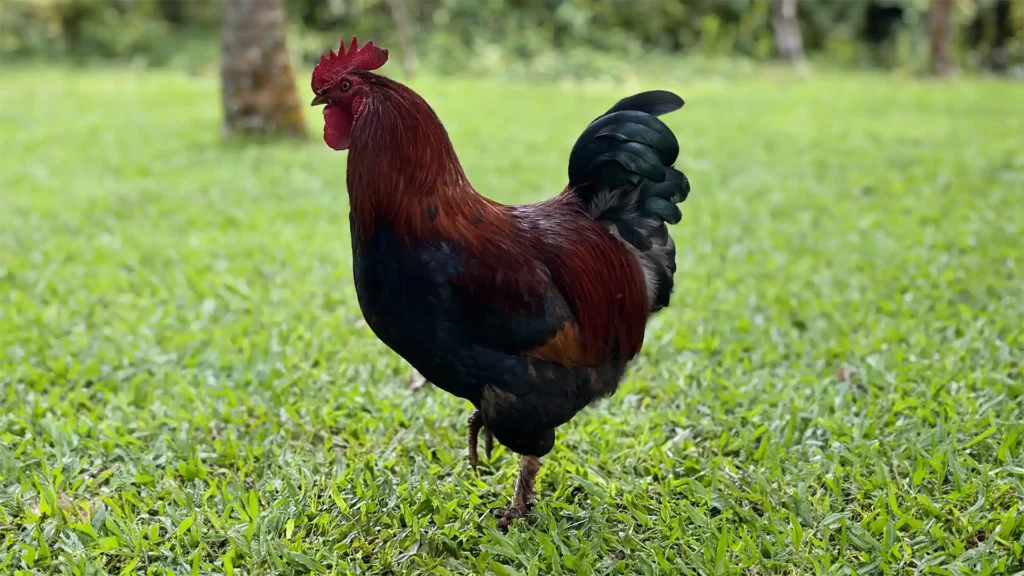
You might not associate the humble chicken with the most feared and famous of all of the dinosaurs, but based on molecular research scientists have discovered that chickens are closest living relative to the T-rex!1Schweitzer, MH, Asara JM, Freimark LM, Phillips M, Cantley L. 2007.Protein Sequences from Mastodon and Tyrannosaurus Rex Revealed by Mass Spectrometry. Science. Issue 5822, pp. 280-28.
Full-time foragers
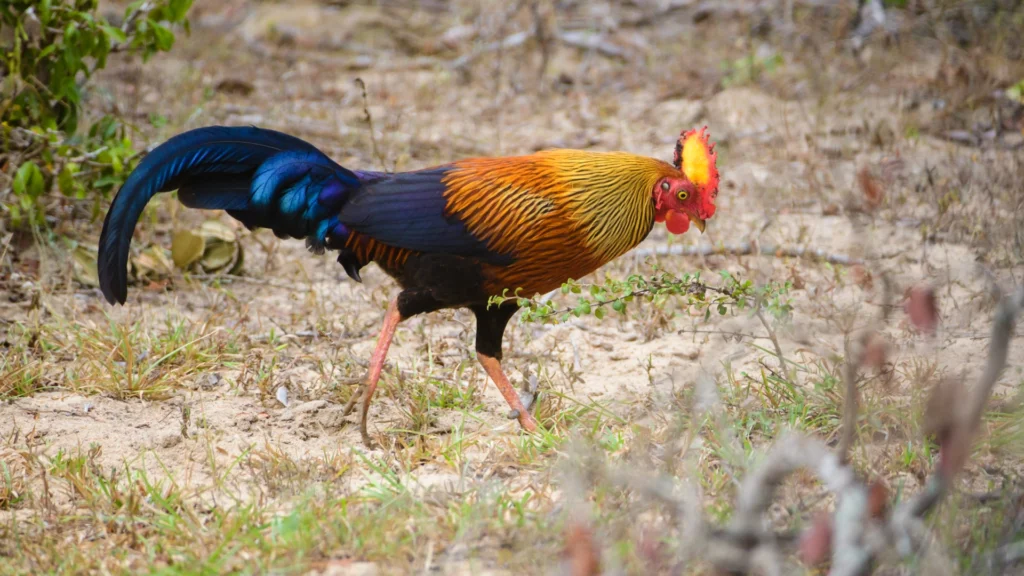
Junglefowl are active early in the morning, sleep during the day and wake again from late after-noon until dusk. Much of their day is spent foraging for insects, small snakes or lizards, and scratching at the ground looking for seeds and berries.
Chickens are sophisticated talkers

Chickens communicate with 24 to 30 vocalisations, each can be nuanced and with a distinct meaning. These calls include everything from roosters saying “I’ve found food” with an excited, rapid “tuck-tuck-tuck” to a soft, vibrating warning “errrr” that spurs little chicks to run to their mums or to flatten to the ground.2Smith CL, Zielinski SL. 2014. Brainy Bird. Sci Am; 310(2):60-65.
Chickens have their own distinctive voices

Every rooster’s crow call is unique and correlates with his comb length (the feathered crest on the top of his head) – an indicator of male dominance.3Appleby MC, Mench JA, and Hughes BO. 2004. Poultry Behaviour and Welfare. CABI Publishing p.72. Males will listen to each other’s calls to assess the dominance status of other males.4Leonard ML and Horn AG. 1995. Crowing in relation to status in roosters. Animal Behaviour 49:1283-90.
Chickens recognise each other’s faces
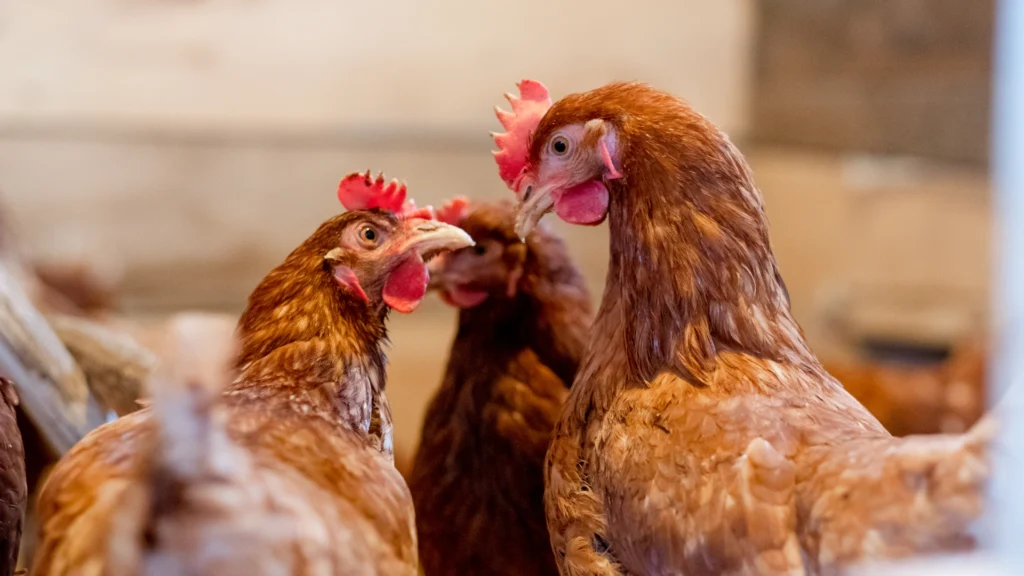
Chickens recognise a large number of other chickens, not only from within their group but out-siders, too.5D’Eath RB, Stone RJ.1999.Chickens use visual cues in social discrimination: an experiment with coloured lighting. Appl Anim Behav Sci. 62:233–242. Research has shown that they can do this even when they are shown colour slides of chickens in their flock!6Bradshaw RH, Dawkins MS. Slides of conspecifics as representatives of real animals in laying hens (Gallus domesticus) Behav Process. 1993;28:165–172.
A natural hierarchy
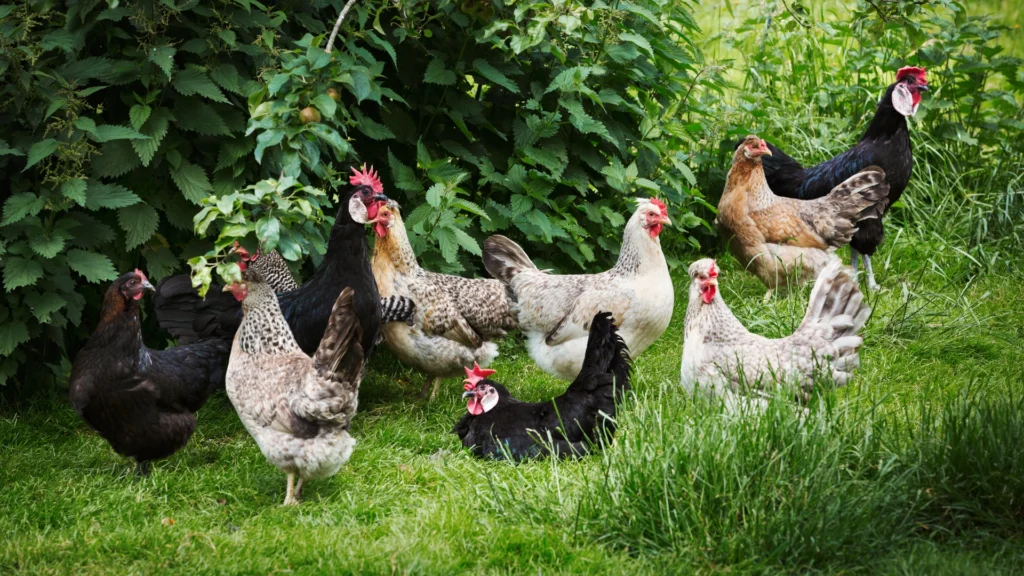
Chickens are naturally social birds who, in the wild, live together long-term as a flock in groups of four to 13 individuals of varying ages. A flock will always have a distinct hierarchy or ‘pecking order’, giving dominant individuals priority over food access and nesting locations.7Smith CL, Zielinski SL. 2014.The Startling Intelligence of the Common Chicken. Scientific American.
A dedicated mum
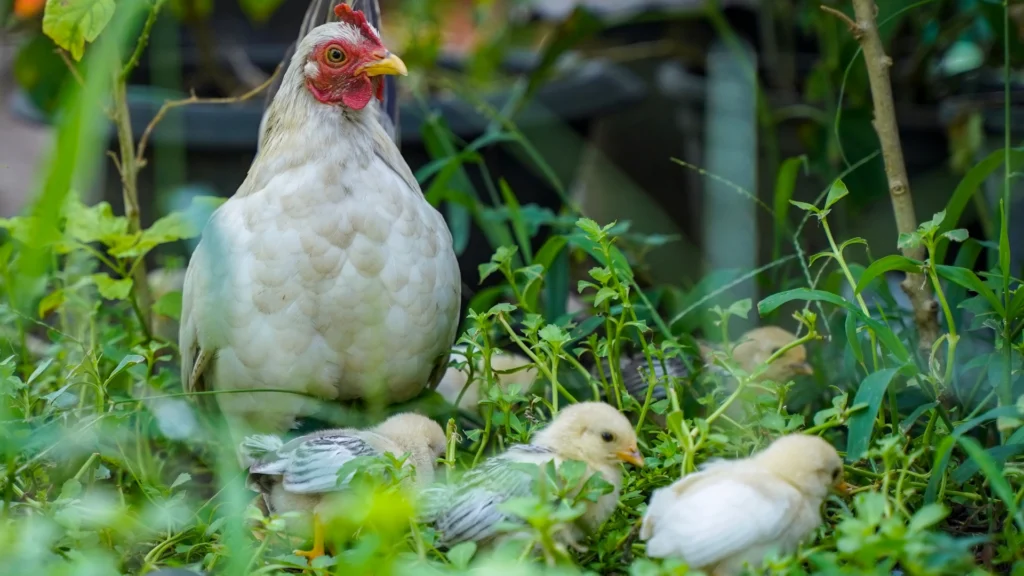
Wild chickens lay between 10 to 15 eggs a year during breeding season. To make sure that her eggs are safe, hens will leave the group and find a secluded nest site ready to lay.8Weeks CA and Nicol CJ. 2006. Behavioural needs, priorities and preferences of laying hens. World’s Poultry Science Journal. 62:296-307. After laying her eggs the hen will sit on them day and night for three weeks. She will leave the nest only once a day to get food and water and dust bathe. The average size of each brood is 4-6 chicks.
Chicks talk to their mums before they have even hatched
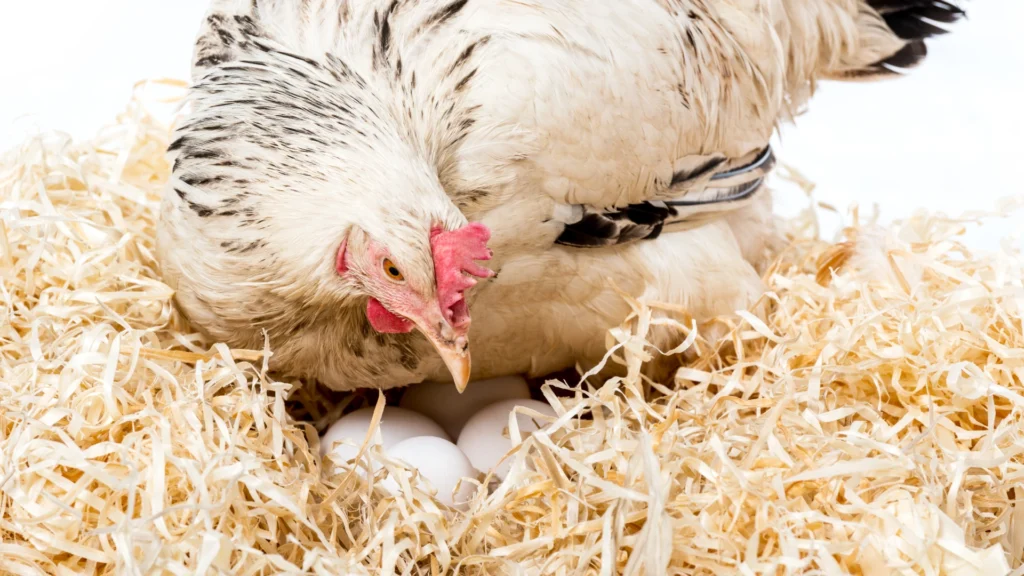
Chicks make calls from inside their egg to let their mum know if they’re distressed from being cold or when they’re happy. Chick brothers and sisters communicate with each other whilst still in their eggs to plan hatching at the same time.9Rogers LJ. 1995. The Development of Brain and Behaviour in the Chicken CAB International 51-2.
Hens are very protective of their young
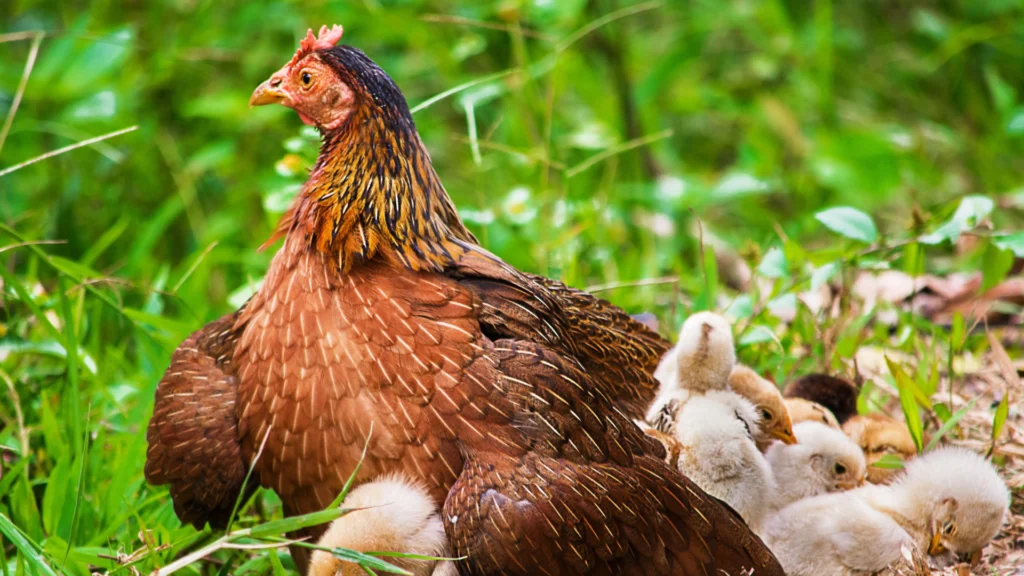
A mother hen will risk her own life to save her chicks. In the wild, if a predator detects the hen’s nest she will become raucous and draw potential predators to herself in an attempt to divert attention away from her chicks.10Collias NE and Collias EC. 1967. A field study of the Red Jungle Fowl in north-central India. The Condor 69(4):360-86.
Chickens have highly sensitive beaks

Chickens’ beaks are very important in the way that they experience the world – they use them to pick up objects, preen, nest and defend against attackers. Just like our fingertips, the tip of the beak is highly sensitive. They are filled with nerve endings for touch, pain, taste and temperature.11Gentle, MJ. J Breward J. 1986. The bill tip organ of the chicken. Agricultural and Food Research Council’s Poultry Research Centre. 79-85 12Freire R, Eastwood MA, Joyce M. 2011. Minor beak trimming in chickens leads to loss of mechanoreception and magnetoreception. J Anim Sci. 89(4): 1201-6.
Chickens feel empathy

The ability to empathise has been associated mainly with highly intelligent species such as dol-phins, great apes, elephants, pigs and dogs, but chickens can be added to that list too. Studies have shown hens displaying signs of anxiety when witnessing her chicks being distressed by a puff of air – a clear sign of a basic form of empathy.13Edgar JL, Lowe JC, Paul ES, Nicol CJ. 2011 Avian maternal response to chick distress, Royal Society, 3129-34.
Chickens have better eyesight than us – and see more colours!

Chickens have excellent eyesight, allowing them to focus close-up and far away at the same time!14Dawkins MS. 1995 How do hens view other hens—the use of lateral and binocular visual-fields in social recognition. Behaviour.132:591. They have tetrachromatic vision, which means that chickens can see more colours than humans can, including ultraviolet light.15Ham AD, Osorio D. 2007 Colour preferences and colour vision in poultry chicks. Proc R Soc B.;274.
Chickens are as clever as monkeys!
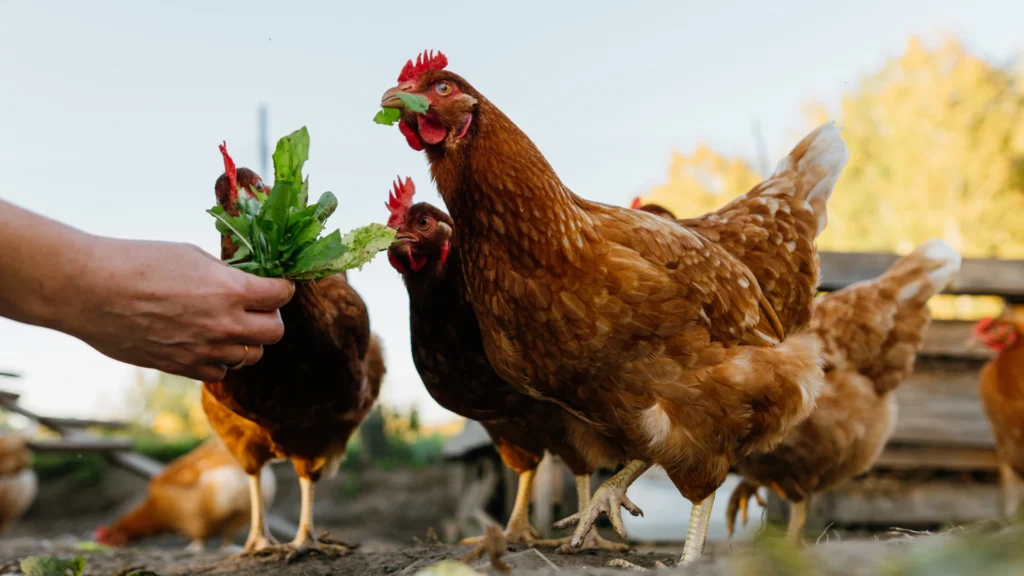
An increasing number of studies have shown that chickens’ intelligence rivals that of dogs, pri-mates and in some tasks, human toddlers! Chickens can count to 1016Rugani R, Fontanari L, Simoni E, Regolin L, and Vallortigara G. 2009 Arithmetic in newborn chicks, Proc. R. Soc. B.2762451–2460., display a high level of self-control17Abeyesinghe SM, Nicol CJ, Hartnell SJ, Wathes CM. 2011. Can domestic fowl, Gallus gallus domesticus, show self-control? Anim Behav. 2005;70:1–11., are capable of social learning18Johnston ANB, Burne THJ, and Rose SPR. 1998. Observational learning in day-old chicks using a one-trial passive avoidance learning paradigm. Animal Behaviour56:1347-53., have great memory19Cozzutti C, Vallortigara G. Hemispheric memories for the content and position of food caches in the domestic chick. BehavNeurosci. 2001;115:305–313., and have the ability to deceive others to benefit themselves – a sign of ‘Machiavellian intelligence’.20Gyger M, Marler P. Food calling in the domestic fowl, Gallus gallus: the role of external referents and deception. Anim Behav. 1988;36(2):358–365.
Chickens outnumber humans three to one!

There are over 23 billion chickens in the world at any one time – outnumbering humans by more than three to one. Obviously, the overwhelming majority of these are bred to produce meat or eggs for humans.21https://www.statista.com/statistics/263962/number-of-chickens-worldwide-since-1990
Young and old
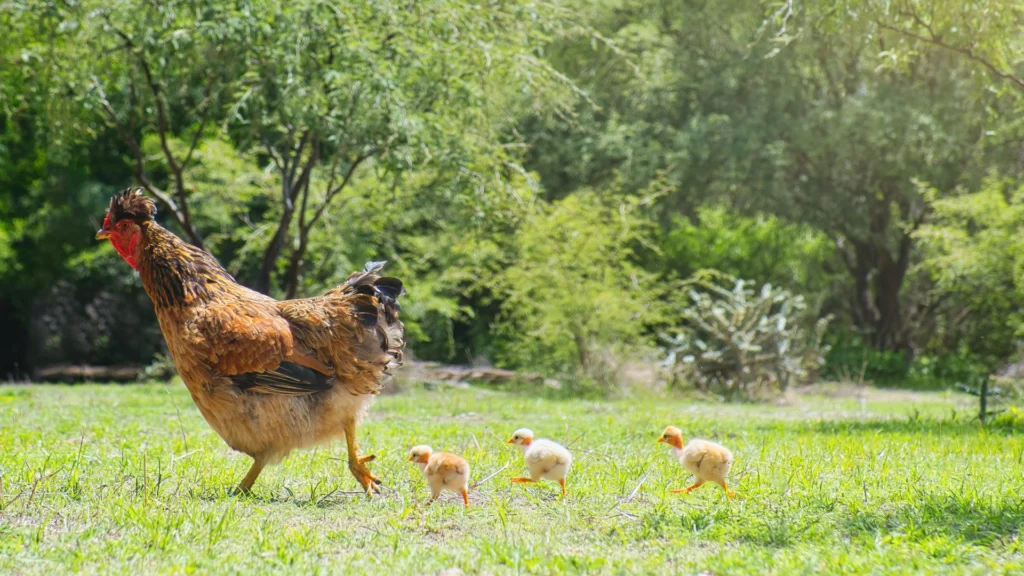
A chicken’s natural lifespan is usually 5-8 years and in some cases they can live 10-12 years. Fe-males over a year old are referred to as hens and younger females as pullets. Males over a year old are called roosters whilst younger males are referred to as cockerels.
Egg-laying hens in Uganda
There are over 37 million farmed chickens in Uganda, being farmed for their eggs and meat.22https://www.fao.org/3/CA1904EN/ca1904en.pdf In Uganda, it is more common to farm chickens for their meat (broiler chickens) than for their eggs23https://www.farmingug.com/poultry/local-chicken-farming-in-uganda/ but farmers of all scales will also take some eggs from the chickens, and egg production is becoming big business. The demand for eggs by Ugandans has been increasing in recent years, along with the price, making it an appealing business to farmers.
There are two main commercial chicken breeds used for eggs in Uganda. These are the brown egg-laying hens such as Gold Line, Lehman Brown, and Isa Brown, and the smaller white egg-laying hens such as the Isa White, Harvard White, Sever White and Bovanch White.24https://www.aboutuganda.com/agriculture/poultry-farming-in-uganda Less intensive farmers and households might also keep some local breeds for eggs, although it is less common.
In 2020, Uganda produced nearly 45,000 tonnes of eggs, which has been increasing at an average yearly rate of four per cent since 1971. In 2022, Uganda slaughtered over 52 million chickens.25https://www.fao.org/faostat/en/#home
How egg-laying hens are farmed
Incubation and early growth
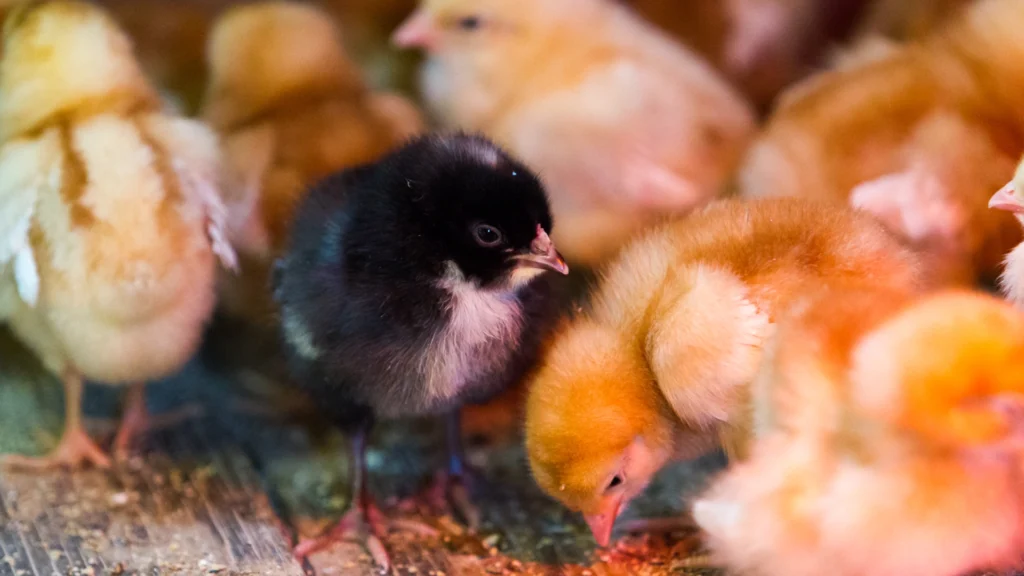
The incubation period for layer chickens is approximately 21 days. Hatcheries in Uganda specialise in hatching eggs for poultry, providing hens to farmers. Chicks are initially housed in a crowded brooder – a heated ‘nursery’ – for about two months to ensure they receive adequate warmth and food.
This period is also when the chicks are ‘debeaked’. Squashed into wire mesh cages frustrates these naturally active birds. Boredom, lack of space and severe discomfort, means a ‘pecking order’ is replaced by ‘injurious feather pecking’ (IFP).
Feather pecking can start when chicks are just a few weeks old. It can also spread rapidly within a flock as a learned behaviour. Feather pecking means birds peck at each other – but as the birds are confined together in cages, there is no escape. It leads to increasingly exposed patches of skin, which become red and sore. A visibly open wound or blood can then drive hens to cannibalism.
Debeaking (known as beak trimming in the poultry industry) involves the partial removal of the tip of a hen’s beak, a process which is performed without any anaesthesia or postoperative treatment. In Uganda, it is common for debeaking to be done with a hand debeaker – a pair of blades operated like scissors – or a debeaker machine, which slices the tip of the beak off with a heated blade. Debeaking causes as a chicken’s beak is highly sensitive, rich in blood vessels and nerve endings. The process can lead to depression, inactivity and loss of appetite due to the pain.
The main reason for stereotypical and aggressive behaviour in laying hens is squarely down to the unnatural way they are kept, which – even in higher welfare cases – does not truly reflect their natural state nor allow them to express all natural behaviours. Sanctuaries which offer hens a genuinely free-range life in small flocks find that birds do not feather peck and have beautiful, healthy, shining feathers.
Housing
Egg-laying hens are usually farmed in one of three systems: free-range, semi-intensive and intensive. Smallholder and household farmers often allow their hens free range, but most commercial farms use semi-intensive and intensive systems – both forms of factory farming.
Free-range
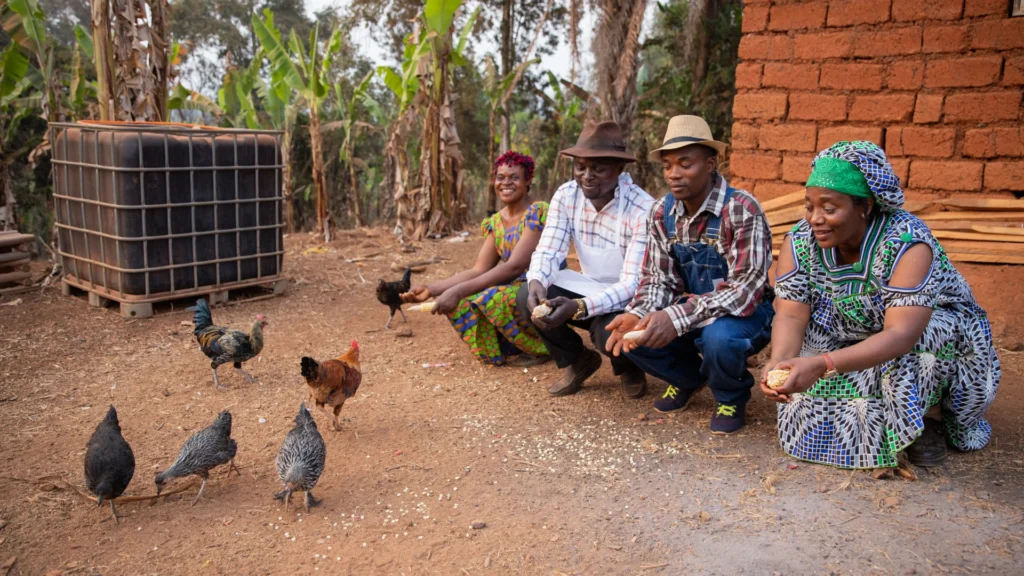
Free-range chickens account for about 55 per cent of the chicken population.22https://www.fao.org/3/CA1904EN/ca1904en.pdf Chickens are kept in free-range systems across the country, mainly on household and smallholder farms. Over 40 per cent of Uganda’s population live in a household that keeps chickens, and 80 per cent of these allow the chickens free range.22https://www.fao.org/3/CA1904EN/ca1904en.pdf Flocks of between two or three to a dozen birds are usually made up of indigenous breeds. Most free-range chickens are kept for subsistence farming, and not usually for the meat or egg market.
Intensive and semi-intensive
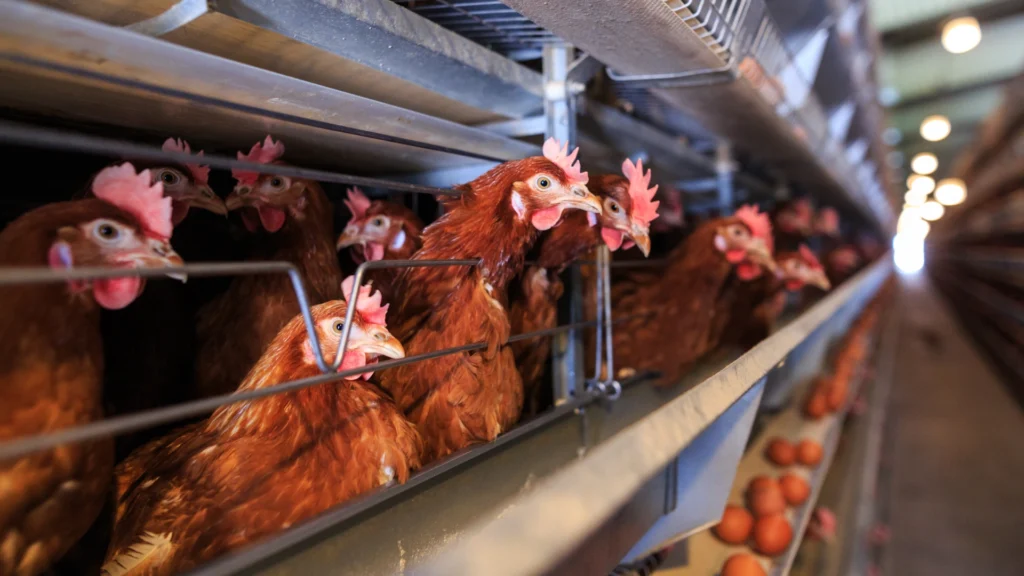
Intensively and semi-intensively farmed chickens account for about 45 per cent – and rising – of the chicken population.22https://www.fao.org/3/CA1904EN/ca1904en.pdf In semi-intensive systems, the flocks are smaller (hundreds rather than thousands of birds), and the birds are sometimes allowed out to a fenced area.
The intensive system includes hens confined to barns on the “deep litter” system, where the floor of the barn is covered in an absorbent litter, and the battery system, where hens are imprisoned in small cages, stacked on top of each other, row upon row.23https://www.farmingug.com/poultry/local-chicken-farming-in-uganda/
In a deep litter system, the floor is covered in a litter of straw, wood shavings and any other available material. The litter is designed to soak up the chickens’ waste but it means that birds living on deep litter are always in contact with their faeces. With thousands of birds sharing the same space, the litter can become wet very quickly. By sitting in their own waste, hens are prone to suffer from contact dermatitis, where the skin is chemically burned and eventually turns black.
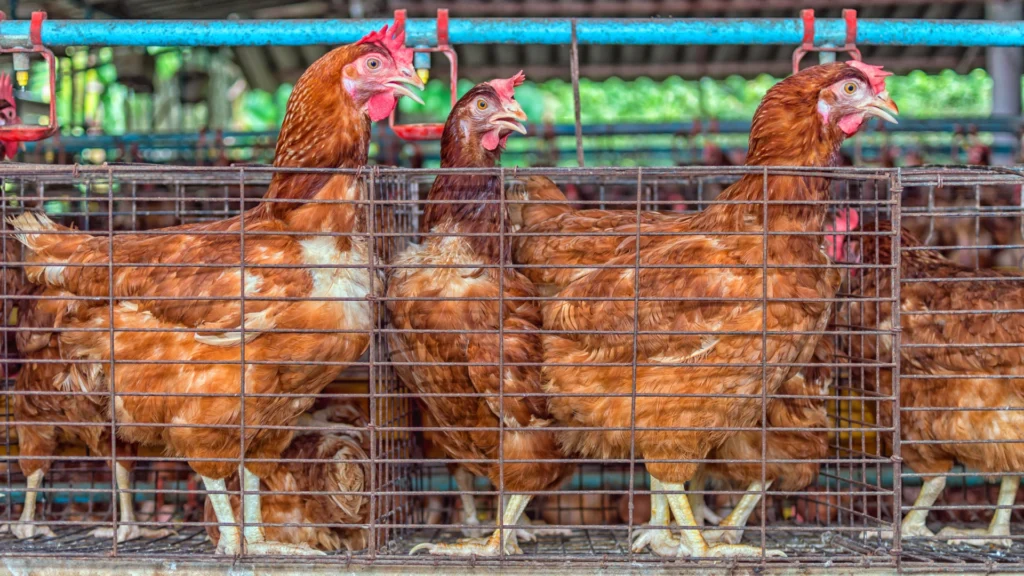
Battery cages are illegal in the UK and the EU, yet are still commonly used in Uganda, despite opposition from animal welfare advocates.26https://allafrica.com/stories/202308240280.html As soon as a hen is old enough to lay eggs – at around 18 weeks – she will be placed in a cage, where she will spend the rest of her miserable life.
These prison-like cages provide hens with approximately 550cm2 of space – about the area of a sheet of A4 paper. A hen’s average wingspan is about four times this size, and so she spends the vast majority of her life unable to even spread her wings. Birds in battery cages spend their entire life sitting or standing on sloping wire mesh floors with no room to move around or exhibit any natural behaviour. They live under controlled artificial lighting – denied fresh air and sunshine. They are fed a monotonous diet of pellets, nothing like their natural diet. Their life in a cage is cruel and painful.
Injuries
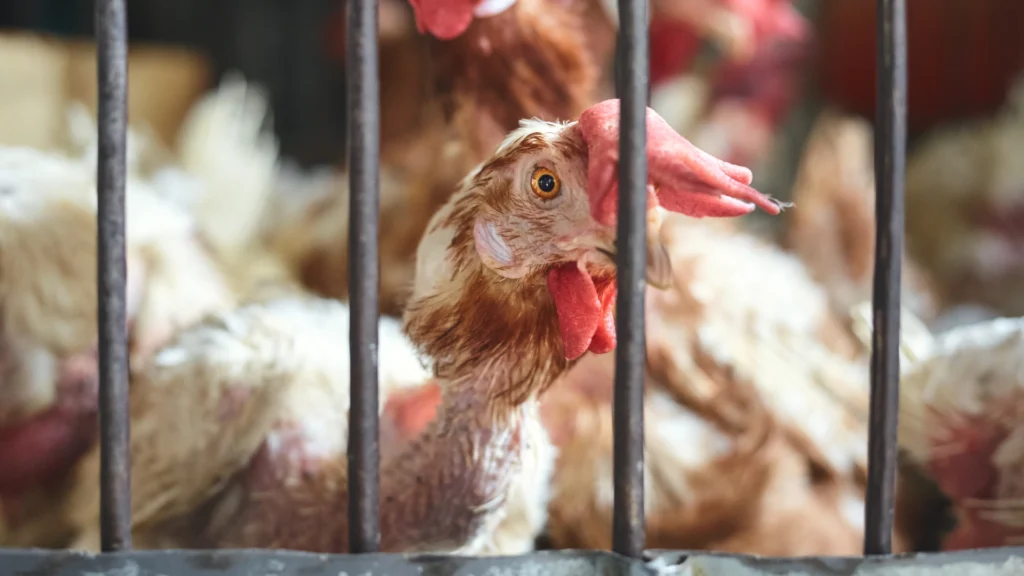
Hens kept in cages or crowded barns have barely enough space to move around and so have little chance to exercise. Egg Laying hens are selectively bred to produce about 25 times more eggs than is natural. In the wild, hens lay about 12 eggs a year. Farmed hens are bred to lay about 300! The hens cannot remain healthy as they lose calcium from their bones to form the eggshells. The lack of exercise and loss of calcium due to the hundreds of eggshells a hen has to produce in her lifetime, produces a high rate of osteoporosis and broken bones.
Bone fractures in hens are one of the major welfare concerns for farmed hens. Not only do they cause them pain for weeks at a time but a fracture can limit their movement, making it difficult for them to get up to perches or protect themselves from aggressive pecking.
Standing on wire for the entirety of their lives, hens often develop sores on their legs and feet. Also red and sore featherless patches on the breast and under the legs can develop into sores when exposed to ammonia from their urine.
How egg-laying hens are killed
Most egg-laying hens live short and miserable lives. Their optimum laying capacity is reached by the time they are one or two years old, and most are considered ‘spent’ at around 72 weeks old. Farmers are advised to slaughter laying hens when their egg production drops below 40 per cent.27https://naads.or.ug/poultry/layer-chicken/ Egg-laying hens face the same death as broiler chickens.
Transportation

The transportation of hens to slaughterhouses in Uganda is a critical stage that poses significant welfare concerns. Chickens are often transported long distances in vehicles not designed for animal transportation, leading to stress, injuries, and even death. During transportation, may die, suffer haemorrhages and other critical physical trauma being squeezed in cages and transported for miles.
Even chickens from smallholder farms travelling to local markets face a terrifying journey, often being hung upside down from the handlebars of a motorbike.28https://www.eyesonanimals.com/fewer-poultry-transported-upside-down-at-kabirizi-market-uganda/
Slaughter
Hens kept in smallholder and household free range systems are killed without any kind of stunning. The slaughterer will usually pin the chicken down by standing or kneeling on the chicken’s wings. They will then take a knife to the throat of the chicken and saw through their flesh. Blood spurts from the wound as the hen is left to bleed to death for several minutes. The bird is supposed to be killed with a single slice, but inadequately sharp knives mean that several repeated cuts have to be made to tear through the bird’s skin. This results in unthinkable pain and suffering.
In the few modern slaughterhouses in Uganda, chickens are suspended by their feet on a moving line. They are then stunned by either an electrical current or by being smashed on the head with a metal rod. Then, as described above, their throat is cut and they are bled to death.29https://www.agriculture.go.ug/wp-content/uploads/2020/07/MAAIF-Poultry-Manual.pdf As around 15 per cent of Ugandans are Muslim, chickens are also killed without stunning so that the meat can be certified halal.
Their carcasses are then scalded in hot water and their feathers are usually plucked out by hand, or sometimes by a machine. After they have had their feathers pulled out, the bird is “eviscerated”, which means all their organs and feet are removed.29https://www.agriculture.go.ug/wp-content/uploads/2020/07/MAAIF-Poultry-Manual.pdf
This should all be done in a sterile environment, but that is rarely the case. On small farms, the chickens are often just killed outside on the ground, or even in the family kitchen.
Zoonotic diseases and superbugs
A zoonotic disease is a disease that can spread between animals and humans. Poultry farming provides the perfect conditions for zoonotic diseases to spread.
One of the most common zoonotic diseases is salmonella. Symptoms of human salmonellosis include fever, diarrhoea and stomach cramps. If it infects the bloodstream it can even become life-threatening. Salmonella is commonly detected in eggs and raw chicken meat. It is particularly prevalent amongst the chickens on intensive farms in Uganda.22https://www.fao.org/3/CA1904EN/ca1904en.pdf
Another concerning zoonotic disease is bird flu (H5N1). Bird flu is more common on free range farms in Uganda.22https://www.fao.org/3/CA1904EN/ca1904en.pdf According to the European Centre for Disease Prevention and Control, “almost all human infections have been related to close contact with infected or sick birds or their faecal products in domestic settings, eg in ‘wet markets’ in Asia or in backyard farming,”30https://www.ecdc.europa.eu/en/zoonotic-influenza/facts/factsheet-h5n1 which is common in Uganda.
In an effort to control the diseases on farms, farmed animals are often prescribed antibiotics. However, “inappropriate use of antibiotics could lead to antimicrobial resistance in humans,” which means antibiotics we have long-trusted to treat illnesses may no longer work. This will “likely create new public health threats. Some, such as emerging zoonotic diseases, may have pandemic potential, add to existing food safety hazards and proliferation of antimicrobial resistance pathogens.”22https://www.fao.org/3/CA1904EN/ca1904en.pdf
Intensively farmed egg-laying hens face many challenges in Uganda. From being mutilated at such a young age, to poor housing, inadequate nutrition and an increased risk of disease and injury. Even when chickens are lucky enough to be raised on a small free-range farm, they still meet a horrendous end. All this suffering can be avoided if you choose a plant-based diet.
References
References
- 1Schweitzer, MH, Asara JM, Freimark LM, Phillips M, Cantley L. 2007.Protein Sequences from Mastodon and Tyrannosaurus Rex Revealed by Mass Spectrometry. Science. Issue 5822, pp. 280-28.
- 2Smith CL, Zielinski SL. 2014. Brainy Bird. Sci Am; 310(2):60-65.
- 3Appleby MC, Mench JA, and Hughes BO. 2004. Poultry Behaviour and Welfare. CABI Publishing p.72.
- 4Leonard ML and Horn AG. 1995. Crowing in relation to status in roosters. Animal Behaviour 49:1283-90.
- 5D’Eath RB, Stone RJ.1999.Chickens use visual cues in social discrimination: an experiment with coloured lighting. Appl Anim Behav Sci. 62:233–242.
- 6Bradshaw RH, Dawkins MS. Slides of conspecifics as representatives of real animals in laying hens (Gallus domesticus) Behav Process. 1993;28:165–172.
- 7Smith CL, Zielinski SL. 2014.The Startling Intelligence of the Common Chicken. Scientific American.
- 8Weeks CA and Nicol CJ. 2006. Behavioural needs, priorities and preferences of laying hens. World’s Poultry Science Journal. 62:296-307.
- 9Rogers LJ. 1995. The Development of Brain and Behaviour in the Chicken CAB International 51-2.
- 10Collias NE and Collias EC. 1967. A field study of the Red Jungle Fowl in north-central India. The Condor 69(4):360-86.
- 11Gentle, MJ. J Breward J. 1986. The bill tip organ of the chicken. Agricultural and Food Research Council’s Poultry Research Centre. 79-85
- 12Freire R, Eastwood MA, Joyce M. 2011. Minor beak trimming in chickens leads to loss of mechanoreception and magnetoreception. J Anim Sci. 89(4): 1201-6.
- 13Edgar JL, Lowe JC, Paul ES, Nicol CJ. 2011 Avian maternal response to chick distress, Royal Society, 3129-34.
- 14Dawkins MS. 1995 How do hens view other hens—the use of lateral and binocular visual-fields in social recognition. Behaviour.132:591.
- 15Ham AD, Osorio D. 2007 Colour preferences and colour vision in poultry chicks. Proc R Soc B.;274.
- 16Rugani R, Fontanari L, Simoni E, Regolin L, and Vallortigara G. 2009 Arithmetic in newborn chicks, Proc. R. Soc. B.2762451–2460.
- 17Abeyesinghe SM, Nicol CJ, Hartnell SJ, Wathes CM. 2011. Can domestic fowl, Gallus gallus domesticus, show self-control? Anim Behav. 2005;70:1–11.
- 18Johnston ANB, Burne THJ, and Rose SPR. 1998. Observational learning in day-old chicks using a one-trial passive avoidance learning paradigm. Animal Behaviour56:1347-53.
- 19Cozzutti C, Vallortigara G. Hemispheric memories for the content and position of food caches in the domestic chick. BehavNeurosci. 2001;115:305–313.
- 20Gyger M, Marler P. Food calling in the domestic fowl, Gallus gallus: the role of external referents and deception. Anim Behav. 1988;36(2):358–365.
- 21
- 22
- 23
- 24
- 25
- 26
- 27
- 28
- 29
- 30

